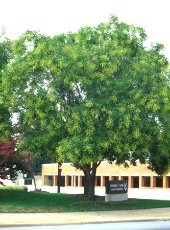





 2
2








Permaculture...picking the lock back to Eden since 1978.
Pics of my Forest Garden
 1
1




Greg Martin wrote:My apologies for believing what I read about moringa being a nitrogen fixer....I have no direct experience with moringa being from Maine. Very good find Jason. There should be some great nitrogen fixers down there to choose from for your acreage.
 2
2




Iterations are fine, we don't have to be perfect
My 2nd Location:Florida HardinessZone:10 AHS:10 GDD:8500 Rainfall:2in/mth winter, 8in/mth summer, Soil:Sand pH8 Flat




S Bengi wrote:Spinach and others in that family might be dangerous to eat due to high nitrate levels, even though they aren't a nitrogen fixers. This is because spinach will store any available nitrogen if you over-fertilize it. Unlike say cabbage/rye/beans, which will just let the extra nitrogen fertilizer leach down into the water table. But under normal condition spinach will not have more nitrogen than legumes.
Moringa is full of minerals and vitamin, so it might promote an explosion of soil life that will help your garden even though it doesn't fix nitrogen or capture as much carbon as C4 grasses.
The main selling point for me with moringa is that, in snake/scorpion/etc infested areas I would much rather stand up and cut my greens, then bend down on my knees.
So to me moringa is still a wonderful/miracle plant.
And finally moringa has plant growth promoting chemicals (think willow extract to promote root growth), so while it isn't fixing nitrogen it is still forcefully marking your garden more lush, but I am not sure if vegetative growth should happen at the expense or root or fruit production.


 1
1




Iterations are fine, we don't have to be perfect
My 2nd Location:Florida HardinessZone:10 AHS:10 GDD:8500 Rainfall:2in/mth winter, 8in/mth summer, Soil:Sand pH8 Flat
 1
1




S Bengi wrote:When I mentioned spinach family I am talking about regular spinach/beet/lambs quarter family aka this:
https://en.wikipedia.org/wiki/Amaranthaceae#Economic_importance
Chaya Mansa is actually in the cassava/castor oil/rubber tree family.
Any type of plant cover is better than no plant cover, likewise any chop and drop is better than nothing. But starting out, I would really only focus on plants in the legume family and grass family. Adler makes a wonderful chop and drop. Also if you can import carbon to your site esp if it is free it will do wonders. You can use animal bedding, stale bread, used vegetable oil, sawdust, woodchip, they will all increase your soil life, which is where the fertility is found in tropical soil even more so than soils up north.

 1
1




Some places need to be wild




Eric Hanson wrote:Jason,
You might consider something like Crimson Clover. Crimson Clover is frequently used as a soil builder. It is a strong nitrogen fixer, fixing among the highest counts of nitrogen of any nitrogen fixer. In your area this is a winter annual, meaning that it will likely only last one season. Consider planting it where you plan to put in garden beds. Since you have 3 years to prepare, you could go a long ways to getting some soil established before planting your garden.
Good Luck,
Eric




Eric Hanson wrote:Jason,
You might consider something like Crimson Clover. Crimson Clover is frequently used as a soil builder. It is a strong nitrogen fixer, fixing among the highest counts of nitrogen of any nitrogen fixer. In your area this is a winter annual, meaning that it will likely only last one season. Consider planting it where you plan to put in garden beds. Since you have 3 years to prepare, you could go a long ways to getting some soil established before planting your garden.
Good Luck,
Eric






Iterations are fine, we don't have to be perfect
My 2nd Location:Florida HardinessZone:10 AHS:10 GDD:8500 Rainfall:2in/mth winter, 8in/mth summer, Soil:Sand pH8 Flat
 3
3




"The rule of no realm is mine. But all worthy things that are in peril as the world now stands, these are my care. And for my part, I shall not wholly fail in my task if anything that passes through this night can still grow fairer or bear fruit and flower again in days to come. For I too am a steward. Did you not know?" Gandolf
 1
1




S Bengi wrote:You might not have to water. In fact it is best if you don't have to water.
You mentioned that there is already grass there already, thats perfect they are already adding fertility to the soil.
I would now scatter some legume seeds and some of them will grow.
For me personally, I like having my fruit trees in nice rows, just like at a orchard. In a regular orchard there is nice orchard grass between the row. In a permaculture setup we want that space to be filled with 12inch high legumes, that we cut every 4 week, down to 3inches. It's that process of continually cutting the legumes/biomass that will promote soil-life and release bio-available minerals. The layer of orchard grass/legume will also cut down on evaporation, thus cutting down how much watering you need, and the legumes will release nitrogen.
Now before we get to that 'permaculture orchard/foodforest' stage we need to prep the site. Which to me means earthworks, adding carbon (biochar, woodchip, logs/sticks, herbicide free straw/hay, compost, etc), possible drip line irrigation, living mulch/covercropsupport species, microbes (compost tea, mushroom slurry, EM, etc), possible rockdust/lime/etc.
So with a focus on the covercrop/support species/pasture mix.
80% grass and legumes
10% herbs (onion, thyme, celery, etc)
10% plants like kale, moringa, comfrey, spinach. (they are usually high in minerals and or have a tap root)


 2
2




Iterations are fine, we don't have to be perfect
My 2nd Location:Florida HardinessZone:10 AHS:10 GDD:8500 Rainfall:2in/mth winter, 8in/mth summer, Soil:Sand pH8 Flat

 4
4




List of Bryant RedHawk's Epic Soil Series Threads We love visitors, that's why we live in a secluded cabin deep in the woods. "Buzzard's Roost (Asnikiye Heca) Farm." Promoting permaculture to save our planet.
 1
1





|
Something must be done about this. Let's start by reading this tiny ad:
Rocket Mass Heater Resources Wiki
https://permies.com/w/rmh-resources
|




